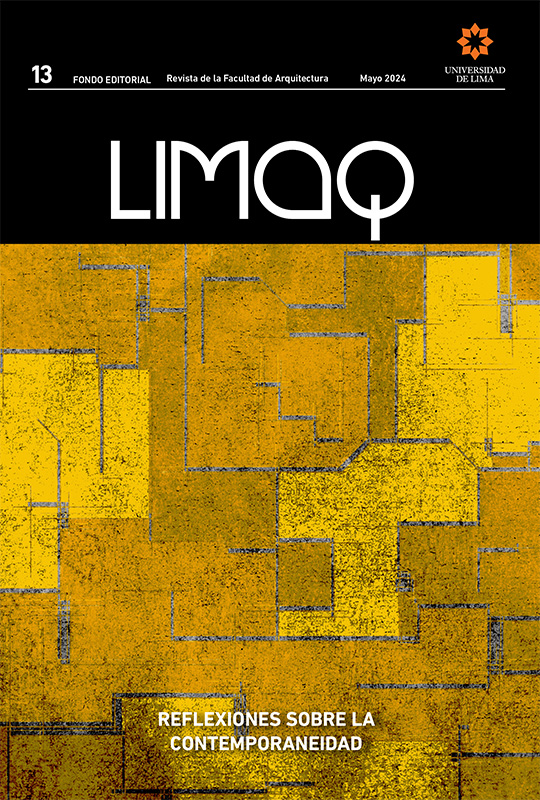Niemeyer in the Desert. Presences of the Russian Avant-Garde in Ibirapuera Park
DOI:
https://doi.org/10.26439/limaq2024.n013.6529Keywords:
architectural drawing, appropriation, Ibirapuera Park, Ivan Leonidov, modernity and modernization, Oscar Niemeyer, suprematismAbstract
This article traces how Oscar Niemeyer and his team’s early draft of the Ibirapuera Park project (1951–1954) employs resources from the art and architecture of the Russian avant-garde of the early 20th century. It presents similarities with two projects by architect Ivan Leonidov regarding formal citations and the dispersion of volumes in space. It states a strong link between the Brazilian architect’s work and the suprematist conception of space, which employs empty space as a “desert condition” that aesthetically elaborates on the isolation characteristic of the modern condition. Such use of space articulates Niemeyer’s tragic perception of the modernization process in Brazil. However, the marquee in Ibirapuera Park suggests an integration of the otherwise dispersed volumes. It allows for the social appropriation of space and the coexistence of diverse groups, thus producing a space where integration between bodies remains possible.
Downloads
References
Blanciak, F. (2014). Revolutionary Objects: Pure Forms and Disorder in Ivan Leonidov’s Work. Journal of Civil Engineering and Architecture, 8(2), 135–142. https://doi.org/10.17265/1934-7359/2014.02.001
Bois, Y.-A. (2016). 1915. In H. Foster, R. Krauss, Y.-A. Bois, Yve-Alain, B. H. D. Buchloh, & D. Joselit (Eds.), Art since 1900: Modernism Antimodernism Post Modernism (3rd ed., pp. 142–146).
Cardozo, J. (1952). Prefácio. In O. Niemeyer (Ed.). Anteprojeto da Exposição do IV Centenário de São Paulo. D. G. Paglia. Edicoes de Arte e Arquitetura.
Cooke, C. (1990). Images in Context. In Architectural Drawings of the Russian Avant-Garde. The Museum of Modern Art. https://assets.moma.org/documents/moma_catalogue_2105_300062983.pdf
Costa, N. M. T. da. (2022). Porque diabo esse cara fez isso? Entrevista a Paulo Mendes da Rocha. Entrevista, 23(090.01). https://vitruvius.com.br/revistas/read/entrevista/23.090/8486.
Cruciol, D. (2021). Aspiral do IV Centenário de São Paulo: O progresso de São Paulo desfeito em juta e gesso. Demonumenta. http://demonumenta.fau.usp.br/aspiral-do-iv-centenario-de-sao-paulo/.
De Magistris, A., & Korob’ina, I. (2009). Ivan Leonidov: 1902–1959. Electa.
Fiz, S. M. (1986). Contaminaciones fi gurativas: Imágenes de la arquitectura y la ciudad como fi guras de lo moderno. Alianza Editorial.
Franco, F. M., Barbara, F., Corullon, M., Visconti J. C., Rosenberg, J. P., Morettin, M., Bogéa, M., & Wisnik, G. (2006). São Paulo: redes e lugares. Representação brasileira na 10ª Mostra Internacional de Arquitetura da Bienal de Veneza. Arquitextos, 07(077.02). https://vitruvius.com.br/revistas/read/arquitextos/07.077/307.
Fundação Oscar Niemeyer (1987). Instituto Miguel Torga. https://www.oscarniemeyer.org.br/obra/pro383
Gozak, A. P. (2002). Ivan Leonidov. Zhiraf.
Gullar, F. (1985). Etapas da arte contemporânea: Do Cubismo ao Neoconcretismo. Nobel.
Gurian, E. P., & Silva, H. A. A. (2014). Marquise do Ibirapuera: suporte ao uso indeterminado. [Dissertação de Mestrado, Faculdade de Arquitetura e Urbanismo, Universidade de São Paulo]. http://www.teses.usp.br/teses/disponiveis/16/16138/tde-29072014-155335/.
Henderson, L. D. (2019). Malevich, the Fourth Dimension, and the Ether of Space One Hundred Years Later. In C. Lodder (Ed.), Celebrating Suprematism: New Approaches to the Art of Kazimir Malevich (pp. 44–80). Brill. https://doi.org/10.1163/9789004384989_005
Malevich, K. (1927). Suprematism. In K. Malevich (Ed.), The Non-Objective World. (pp. 66–102). Paul Theobald and Company. https://monoskop.org/images/3/34/Malevich_Kasimir_The_Non-Objective_World_1959.pdf
Mindlin, H. E. (1999). Arquitetura moderna no Brasil. Aeroplano.
Niemeyer, O. (1952). Anteprojeto da Exposição do IV Centenário de São Paulo. D. G. Paglia. Edicoes de Arte e Arquitetura.
Perrone, R. A . C., Pisani, M. A. J., & Schimidt, R. (2020). Arquitetura e estrutura: leitura e dissecação do edifício da OCA do Parque Ibirapuera. PosFAUUSP, 27(51). https://doi.org/10.11606/issn.2317-2762.posfau.2020.168162
Sainz, J. (2009). El Dibujo de Arquitectura: Teoría e historia de un lenguaje gráfico.Editorial Reverté.
Scully Jr., V. (2002). Arquitetura moderna: a arquitetura da democracia. Cosac & Naify.
Starobinski, J. (1988). 1789: Os emblemas da razão. Companhia das Letras.
Telles, S. S. (1994). O Desenho: Forma e Imagem. Arquitetura e Urbanismo, 55, 91–95. Ed. Pini Ltda.
Underwood, D. (2003). Oscar Niemeyer e o modernismo de formas livres no Brasil. Cosac & Naify.
Valle, M. A. A. (1993). A Condição de Deserto. Oculum (PUCCAMP), 4, 56–58.
Wisnik, G. (2009). Estado Crítico: à deriva nas cidades. Publifolha.
Wisnik, G. (2022). Tentando não afundar na lama: impasses da modernidade brasileira. ARS (São Paulo), 20(46), 24–74. https://doi.org/10.11606/issn.2178-0447.ars.2022.205227
Zein, R. V. (2012). Uma velha e respeitável senhora. Summa+, 126, 134–135.



